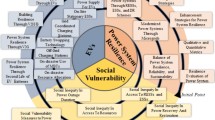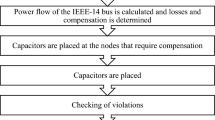Abstract
Power system contingency is an operational state that can happen as a result of a system discontinuity and results in overall system voltage instability. The system has seen intermittent power outages in previous years, according to Ethiopia Electric Power. Parts of the grid system were disrupted during the event, and as a result, there was a partial blackout of the system. Therefore, research proposes identifying the system's exposure to lessen the likelihood of such accidents happening. The proposed method demonstrated on 15 bus system Northwest region of Ethiopia Electrical Power Network using DigSILENT software. System’s exposure was evaluated by using the voltage performance index and the overload performance index. The indices enable the evaluation of two distinct system stress signs, including voltage instability and overloads. Performance index data show that the BDII230 bus to the GoII bus line has highest performance index value (4.9488) from other for N-1 line outage circumstances. This indicates that BDII230 bus to the GoII is most dangerous line for interruption of Northwest region of Ethiopian Electric Power network. But the most sensitive bus for voltage limit violations on this condition are Gondar load bus and Metema load bus. Their voltage profile is 0.908 and 0.923 per unit, respectively. Also, for 50% load demand increasing conditions, Gondar load bus has highest performance index value (20.2352) compared to the other load buses and its voltage profile is 0.8879 per unit. So, applying performance index for Northwest region of Ethiopia Electric Power network is used to know the system performance such as voltage instability and overloading, for forecasting future operation and expansion planning of this area.









Similar content being viewed by others
Data Availability
The corresponding author can provide the datasets used in this study upon reasonable request.
References
Aeggegn DB, Salau A, Gebru Y (2020a) Load flow and contingency analysis for transmission line outage. Int J Electr Eng 3(September):581–594
Aeggegn DB, Salau AO, Gebru Y (2020b) Load flow and contingency analysis for transmission line outage. Arch Electr Eng 69(3):581–594
Airoboman AE, James P, Araga IA, Wamdeo CL, Okakwu IK (2019) Contingency analysis on the Nigerian power systems network. IEEE PES/IAS PowerAfrica Conf. Power Econ. Energy Innov. Africa, PowerAfrica 2019, pp. 70–75
Alayande AS, Jimoh AAG, Yusuff AA (2020) Identification of critical elements in interconnected power networks. Iran J Sci Technol—Tran Electr Eng 44(1):197–211
Alemu M (2017) Study of blackouts on Ethiopian electric power network and identification of system vulnerabilities. Glob Energy Interconnect.
Cruz LM, Alvarez DL, Al-Sumaiti AS, Rivera S (2020) Load curtailment optimization using the PSO algorithm for enhancing the reliability of distribution networks. Energies 13(12):3236–3251
Diahovchenko I, Kolcun M, Čonka Z, Savkiv V, Mykhailyshyn R (2020) Progress and challenges in smart grids: distributed generation, smart metering, energy storage and smart loads. Iran J Sci Technol Trans Electr Eng 44(4):1319–1333
EEP (2014) Ethiopian power system expansion master plan study
Haidar MA, Mohamed A, Hussain A (2019). Vulnerability assessment of power system using various vulnerability indices,” SCOReD 2019—Proc. 2019 4th Student Conference Research and Development Towards Enhancing Res Excell Reg. no. SCOReD, pp. 224–229
Ibeni C (2017) Analysis for electical load flow studies in port Harcourt, Nigeria, using Newton raphson fast decoupled techniques. Am J Eng Res (AJER) 6(12):230–240
Khan U, Yan L (2020), Power swing phenomena and its detection and prevention. In: Proceedings 7th International Conference EEEIC 2020. p. 3
K. Lusii (2023), Contingency Analysis—Baseline, vol. II. pp. 1–44.
Mishra VJ, Khardenvis MD (2012), Contingency analysis of power system. In: 2012 IEEE Students’ Conference Electrical Electronics Computer Science. Innov Humanit Sceecs 2012, vol. 6, no. 1, pp. 15–18
Mogaka O, Orenge R, Ndirangu J (2021) Static voltage stability assessment of the Kenyan power network. J Electr Comput Eng, vol. 2021
Paliya N, Saurava Dash M (2008) Voltage stability, loadability and contingency analysis with optimal integration of renewable distributed generation. Int Res J Eng Technol no. June, p. 1824
Ramachandran MC, Elango K (2018) Improvement of power quality of power system using contingenc y analysis. Int J Eng Technol 7(2):237–241
Swaroop NS (2019) Contingency analysis and ranking on 400 Kv Karnataka network by using mipower. Ijsdr 1(10):287–294
Acknowledgements
We would like to thank the Northwest region of contributed to the analysis and interpretation of the results as well as the writing of the manuscript. Finally, before submission, the final paper was reviewed and approved by all authors. The Ethiopian Electric Power office for allowing this data to be collected. We would also like to thank Mizan Tepi University for assisting us in collecting data and conducting this study.
Funding
This study received no funding.
Author information
Authors and Affiliations
Contributions
M.S.G helped in study conceptualization, study design, gathering the data, doing the analysis and interpretation of the findings, and writing the manuscript. Y.G.W and L.B.T contributed to the analysis and interpretation of the results as well as the writing of the manuscript. Finally, before submission, the final paper was reviewed and approved by all authors.
Corresponding author
Ethics declarations
Conflict of Interests
No competing interests have been disclosed by the authors.
Ethics Approval
Ethical Clearance and Participant Consent.
Not relevant.
Consent for Publication
Not relevant.
Rights and permissions
Springer Nature or its licensor (e.g. a society or other partner) holds exclusive rights to this article under a publishing agreement with the author(s) or other rightsholder(s); author self-archiving of the accepted manuscript version of this article is solely governed by the terms of such publishing agreement and applicable law.
About this article
Cite this article
Geremew, M.S., Workie, Y.G. & Techane, L.B. Identification of System Exposure for the Northwest Region of Ethiopian Electric Power. Iran J Sci Technol Trans Electr Eng (2024). https://doi.org/10.1007/s40998-024-00698-x
Received:
Accepted:
Published:
DOI: https://doi.org/10.1007/s40998-024-00698-x




